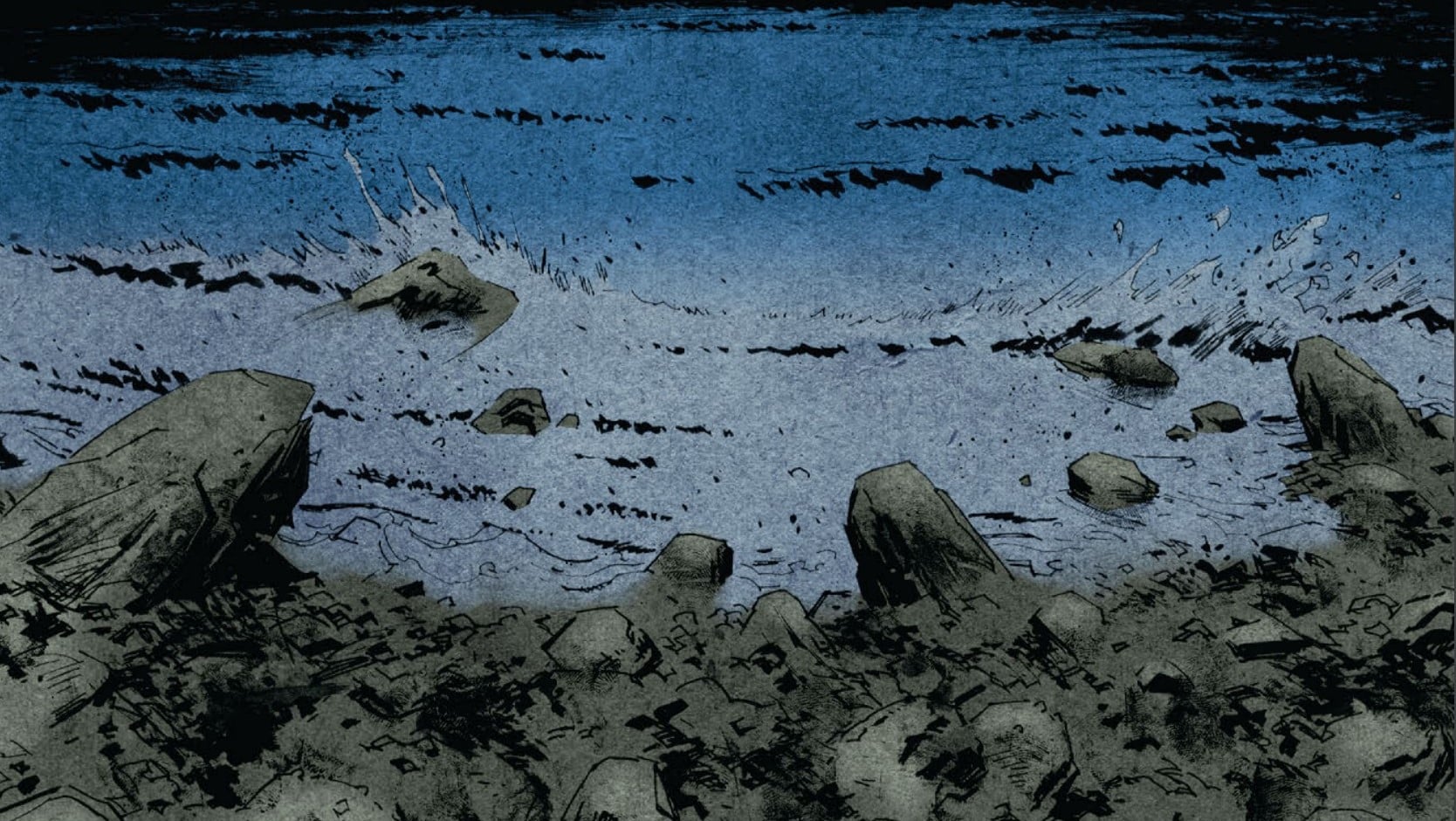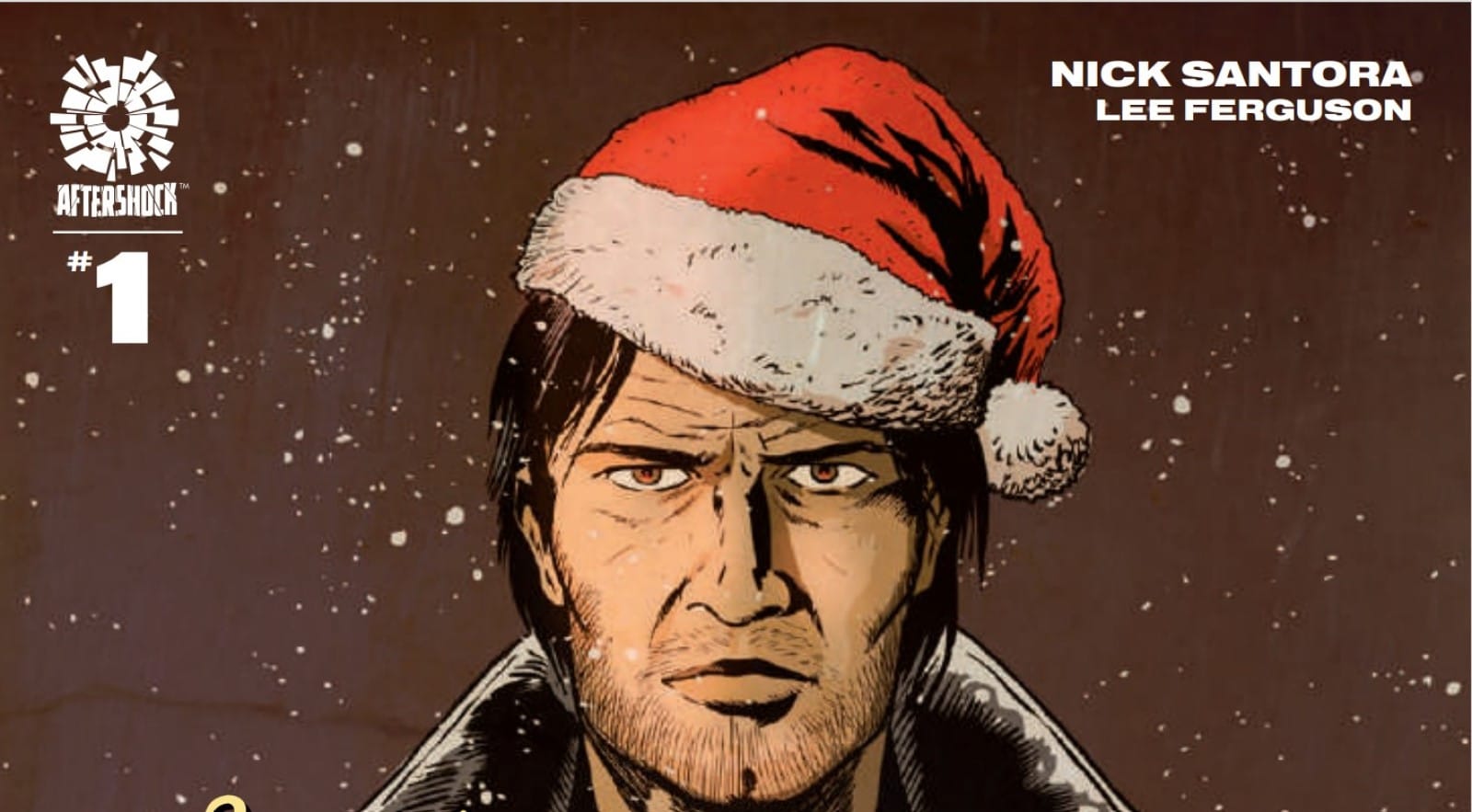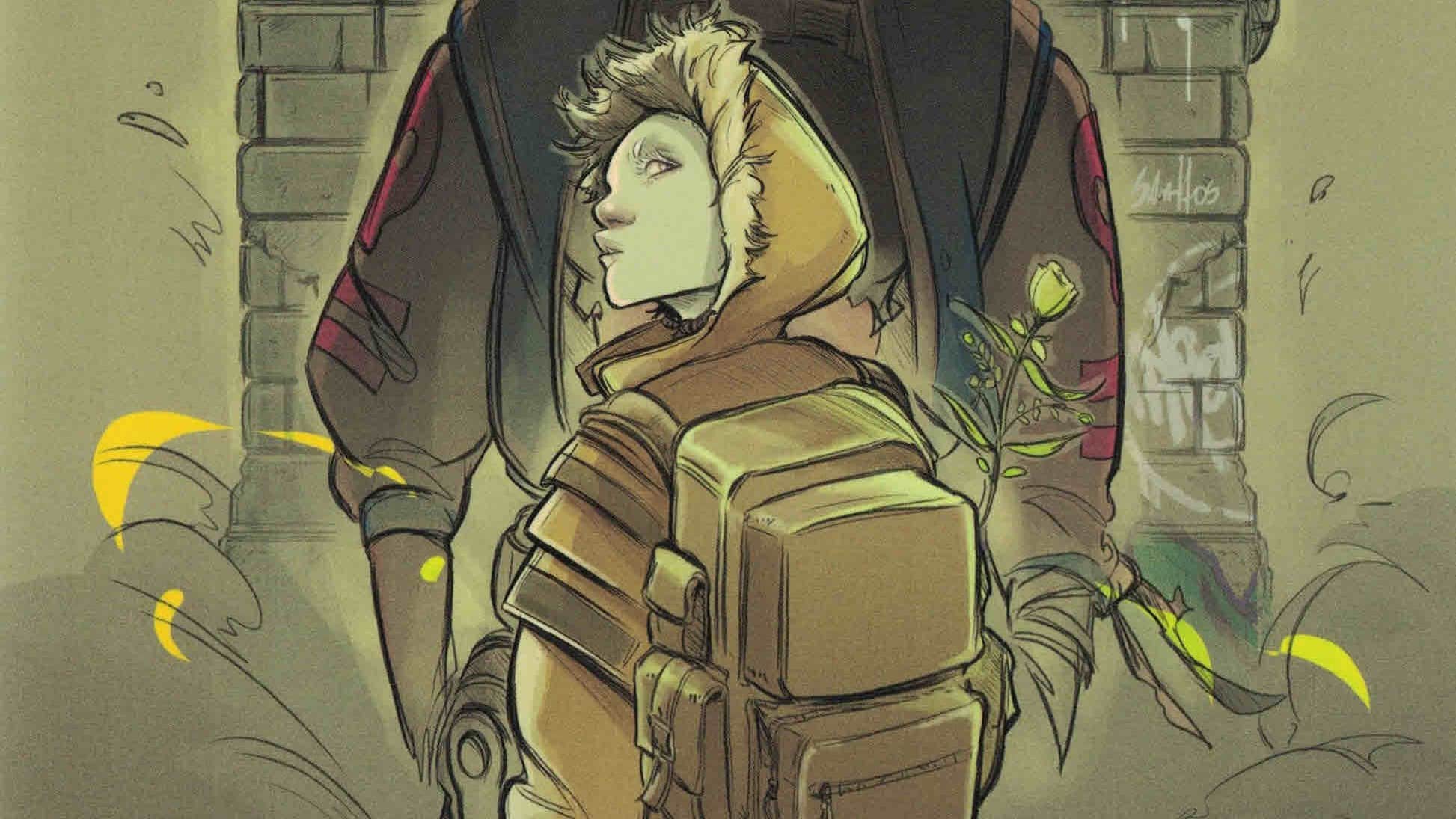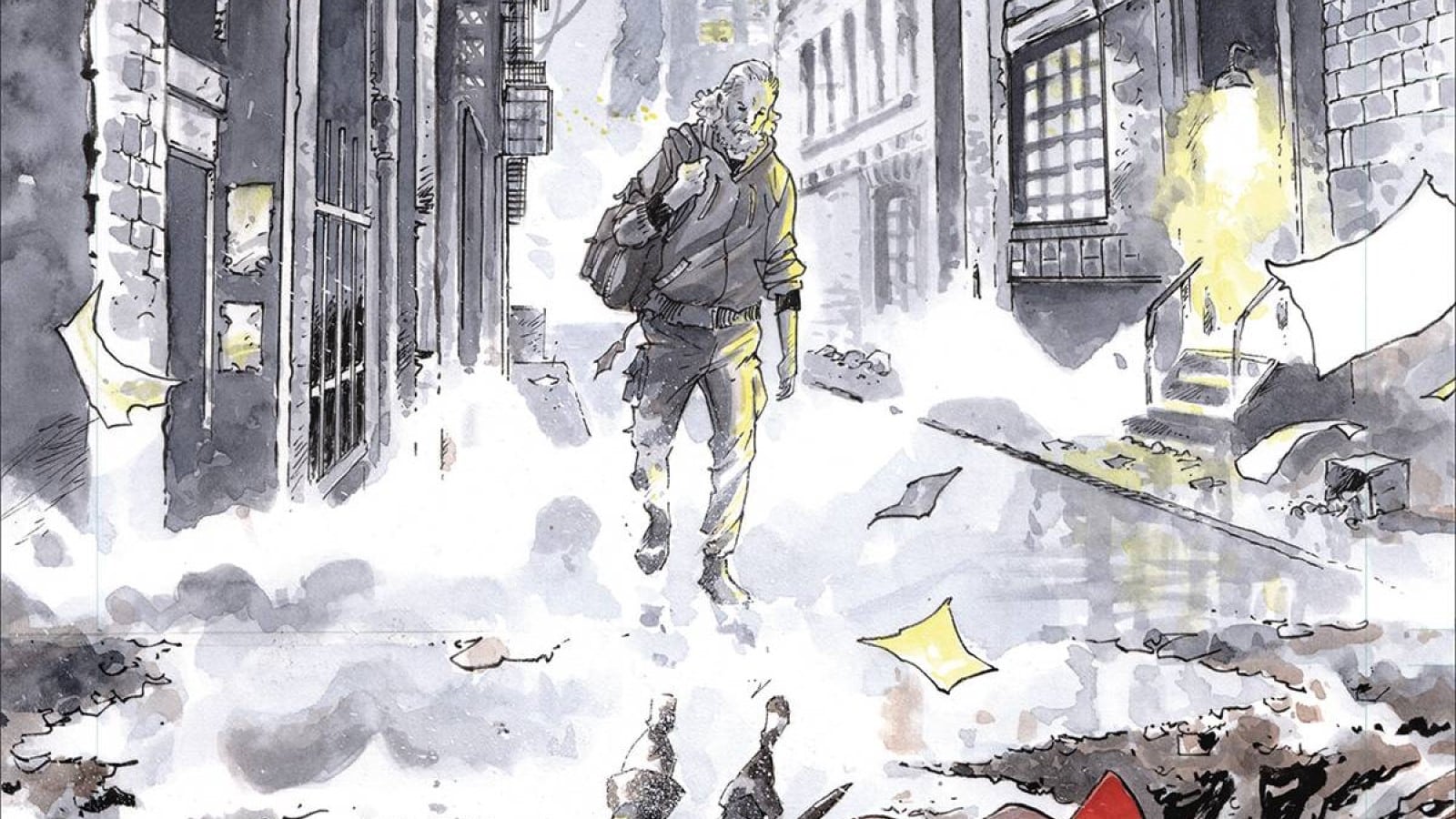We’ve had a pandemic. A global economic crash. And a journalist has been murdered. But one hard-drinking female reporter-turned-detective is on the case. Bylines in Blood #1 is written by Erica Schultz and Van Jensen, illustrated by Aneke, lettered by Cardinal Rae and published by AfterShock.
Will Nevin: OK, I know why I was interested in this book — in my Day Job™, I teach journalism, including media writing, law, ethics and history courses. And then I come here to fuck around. What about you?
Ian Gregory: I’m a sucker for genre, and especially murder mysteries, and I’ll take some cyberpunk, too. I’ve also liked a lot of the books AfterShock has put out in the past, so I thought I’d give this one a shot. It’s very easy to get a good start to a mystery story, but keeping the reader interested past the first murder can be incredibly tricky, so I’m always interested to see how different series handle the genre.
Will: AfterShock does put out a lot of funky genre stuff, doesn’t it? More than anyone else, I feel like they’re willing to give a high-concept book a shot — but some of those books don’t necessarily accomplish what they set out to do. Before we get into the granular details, let’s start with that initial interest investment: Do you feel like any of that got paid off for you?
Ian: I think my overall impression of the genre elements of this story is that they all fall just a little short of being well-developed. Bylines in Blood feels like a book that almost gets to where it wants to be, but it doesn’t quite take the final step needed to make the book feel like it’s doing something new.
Headline: Whatever This Is, Subtle It Ain’t

Will: I stumbled into the intra-office discourse on this one before I actually read it, including your astonishment (is that the right word?) over how “Lady Dick” made it into this book as a nickname and our colleague Ritesh Babu’s observation that the lead character’s official, non-problematic name is literally the Sanskrit word for “truth.” As to the first point, my question is … why? Yes, Satya is a female private detective, but the first Google search result is exactly what you think it would be, and on the page, it only comes across as awkward. Really an unforced error there.
The second thing is a symptom of a larger problem. So far in this story, there’s no subtlety — there’s been a world-changing pandemic and economic disaster, the media industry is in the toilet and the mayor of The City (goshamighty do I dislike that — why not give it a real name?) is a power-hungry goon. I get that this book has aims — namely to do a noir story set in our “fake news” media and political environment — but can’t you do that with a little finesse?
Ian: I am strongly suspecting this is something of a blindspot mystery writers have, based on the existence of the novel Digital Dick by John Mullen. Yes, “dick” can mean detective, but please, just stop and think about what the vast majority of your audience is going to think when they read that phrase. It’s also a nightmare on this series’ SEO: I vaguely recalled the dustup on Twitter about the phrase “Lady Dick” and, thinking it was the name of the series which had ultimately been changed, did some ill-fated Googling (not helped by the fact that the tweets have all since been deleted). At the end of the day, “Lady Dick” is a phrase loaded by other meanings, meanings which are primarily derogatory of trans women. It’s a real blindspot that this phrase made it all the way to the solicits; then, when faced with negative reactions from trans people, remained in the book itself.
As to the subject of subtlety, I absolutely agree. I’m reminded of advice I got in college creative writing classes — ground your story in a single, named place; identify exactly at what time your story takes place. When a story gets too general, it undermines its own setting. “The City” implies that this story could happen in any city. If so, why should I care about the particulars of the setting? Haven’t we already been told that this could happen anywhere?
Will: At the same time that the story feels untethered, it’s also very much centered on our world as it is now, one facing economic and political uncertainty after (during?) a global pandemic. It’s an odd approach to the material, and I’m not sure that you can have it both ways.
And, again, with “Lady Dick” … let’s just not.
Did We Bury the Lead?

Will: All of that other stuff aside, I think I liked the core noir concept here? Satya is an ex-journalist turned hard-drinking PI who’s called in to investigate the death of her former editor. Nothing wrong with that as a central premise, and when you add in the idea (at least here in the beginning) that the mayor may have been involved, that gets at one of the more interesting things the series could say — namely that the death of local journalism has resulted in state and local government shenanigans receiving little to no coverage. Again, ignoring whatever other problems may be going on, is there something here you can dig?
Ian: Certainly, the setup of the mystery is fine, but as I said earlier, the murder is the easiest part. This is a very linear sort of mystery: Satya receives a clue from one location, which directly leads her to another location, which provides her with another clue. This kind of mystery writing bears more in common with an adventure story than detective fiction. There’s no ambiguity in what Satya has to do, or how she can approach the mystery — she just proceeds from set piece to set piece. I never feel like Satya is particularly clever or a particularly good detective because she’s not actually putting any puzzle pieces together. Ironically, that’s where the overlap with journalism could do this series some good: When confronted with lots of disparate pieces of evidence, how can Satya put the story together?
Will: You know, that observation reminds me of a common complaint me and Brother Matt have over at BatChat — we almost never see Batman detecting anything despite his moniker as the World’s Greatest Detective. I would like a little more mystery and intrigue here, but I’m also keeping open the possibility that this gets thornier as the series unfolds.
Ian: Mystery is a really interesting genre because it’s the genre most preoccupied with making the reader feel smart (or like they could have been just a little smarter and solved the case). When a mystery, as in this story, and as often in Batman, is a series of extremely obvious clues in a linear sequence, there’s no space for the reader to puzzle anything out. Bylines in Blood leaves very little space for the reader — every allegory is obvious, every hint transparent.
I also feel the need to shout out Aneke, the artist on this series. Despite the noir tone, Aneke bathes the book in bright, varied colors. The final splash page in particular stands out for its coloring, and Satya’s visual design (the bright yellow of the inside of her blue coat against the melancholy blue of the rain) really stands out. Gripes about the story aside, this is a very pretty issue, and it’s well told: I liked the layouts, like the cluttered panels as she explores a pile of documents, or the use of the lines on the volleyball court to divide the page.
Spin It Forward — What’s Our Second-Day Story?

Will: This is a dangerous question, but where do you think this series is going next? My only guess — if we’re playing by Law & Order rules — is that there’s no way the mayor had a hand in this as the first suspect we’re presented.
Ian: Something this issue does well is establish a solid cast of characters, all of whom are suspect in some way. The ease with which Creepy Eyeball Camera Man proved his innocence immediately raised a red flag for me. The mayor’s blindingly obvious evilness is also, as you thought, a little too blindingly obvious. This book’s fixation on truth and the power of the press naturally brings to mind Donald Trump and alternative facts, but the details of the mayor’s corruption (given in some well-done backmatter) reminded me more of Richard Daley.
I’m hoping the story leans a little more into the cyberpunk aspect. We get the Eyeball Cult, and a passing mention of “The Plague” (which, ugh), but it looks as though the murderer has access to some kind of camera-blurring technology. I’d like to see some exploration of what future-crime could look like, and how you can uncover it when such advanced means of covering wrongdoing exist.
Will: Good on you for mentioning the Creepy Eyeball Camera Man and his cult-ish folk who have committed to documenting every moment of their lives because it reminds me of another good point the book is making: Raw, unprocessed information (like a 24/7 stream of one’s life) is not journalism. It might feel like journalism since you’re presenting an audience with tons and tons of data, but that’s not the role of the journalist. Like I tell my students who are going out to cover a city council meeting or some other public event, journalists are not notetakers or simple chroniclers of ongoing events; journalists are responsible for providing the context necessary for the audience to understand what’s happening and why it’s important. Without that context, information is shallow and pointless — simply noise that’s ultimately counterproductive.
So I hope the book continues to explore these dinguses and why their philosophy is not helpful.
Ian: Great point. I think Bylines in Blood has afforded itself a lot of room to address these issues, and its genre naturally lends itself to hypotheticals about the future of journalism (and the persuasive and political power of good journalism), but I’m not convinced by this first issue that it’s going to take the steps necessary to get there. Everything in this first issue has been obvious, and I’d like to see things move in a more exploratory, novel direction — more faith in its own premise and less reliance on modern political discourse as an allegorical crutch.
Will: Fingers crossed for #2: No more hats on hats.
The Kicker
- The Infopedia backmatter was cute, but I was unduly bothered by how unlike Wikipedia pages it was written.
- An article about The City only highlights what a weird choice that was.
- Satya’s shirt reads “Fack Off,” but the A is an anarchy symbol, and I’m so tired.
- The book has mutants, too. Or something like mutants. Guess that will be explored more.







